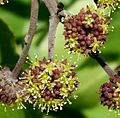
An inflorescence, in a flowering plant, is a group or cluster of flowers arranged on a stem that is composed of a main branch or a system of branches. An inflorescence is categorized on the basis of the arrangement of flowers on a main axis (peduncle) and by the timing of its flowering.

Aralia elata, also known as the Japanese angelica tree, Chinese angelica-tree, or Korean angelica-tree, is a species of woody plant in the family Araliaceae.

The Araliaceae are a family of flowering plants composed of about 43 genera and around 1500 species consisting of primarily woody plants and some herbaceous plants commonly called the ginseng family. The morphology of Araliaceae varies widely, but it is predominantly distinguishable based on its woody habit, tropical distribution, and the presence of simple umbels.

Aralia, or spikenard, is a genus of the family Araliaceae, consisting of 68 accepted species of deciduous or evergreen trees, shrubs, and rhizomatous herbaceous perennials. The genus is native to Asia and the Americas, with most species occurring in mountain woodlands. Aralia plants vary in size, with some herbaceous species only reaching 50 centimetres (20 in) tall, while some are trees growing to 20 metres (66 ft) tall.

Aralia spinosa, commonly known as devil's walking stick, is a woody species of plant in the genus Aralia, family Araliaceae, native to eastern North America. The various names refer to the viciously sharp, spiny stems, petioles, and even leaf midribs. It has also been known as Angelica-tree.

Fatsia is a small genus of three species of evergreen shrubs in the family Araliaceae native to southern Japan and Taiwan. They typically have stout, sparsely branched stems bearing spirally-arranged, large leathery, palmately lobed leaves 20–50 cm in width, on a petiole up to 50 cm long, and small creamy-white flowers in dense terminal compound umbels in late autumn or early winter, followed by small black fruit. The genus was formerly classified within a broader interpretation of the related genus Aralia.

Kalopanax septemlobus, common names castor aralia, tree aralia, and prickly castor oil tree, is a deciduous tree in the family Araliaceae, the sole species in the genus Kalopanax. It is native to northeastern Asia, from Sakhalin and Japan west to southwestern China. It is called cìqiū (刺楸) in Chinese, eumnamu (엄나무) in Korean, and harigiri in Japanese.
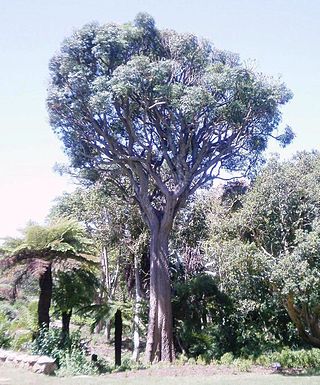
Cussonia spicata, known as spiked cabbage tree, lowveld cabbage tree or common cabbage tree, is a tree in the family Araliaceae, which is native to the moister regions of Sub-Saharan Africa. It is cultivated as a garden plant in areas without extreme degrees of frost. It is one of the favorite foods of wild elephants.

Fatsia japonica, also fatsi, paperplant, false castor oil plant, or Japanese aralia, is a species of flowering plant in the family Araliaceae, native to southern Japan and southern Korea.

Cussonia is a genus of plants of the family Araliaceae, which is native to the Afrotropics. It originated in Africa and has its center of distribution in South Africa and the Mascarene Islands. Due to their striking habit, they are a conspicuous and easily recognizable group of plants. Their genus name commemorates the botanist Pierre Cusson. The Afro-Malagasy and Asian Schefflera, and Afrotropical Seemannaralia genera are related taxa that share several of its morphological characteristics, among which the leaves borne on the end of branches, inflorescences carried on terminal branches or stems, and reduced leaf complexity in developing inflorescences.

Heteropanax is a genus of flowering plants in the family Araliaceae. They are native to Asia.
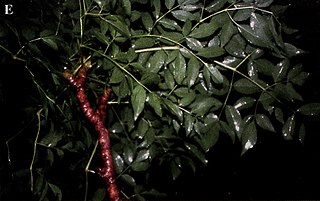
Aralia excelsa is a species of flowering plant in the family Araliaceae. It is native to Mexico, Central America, northern South America and parts of the Caribbean.

Aralioideae is a subfamily of flowering plants contains around 50 recognized genera. These include the genus Panax, to which ginseng belongs. Other notable species are the Angelica-tree, the devil's club, or common ivy.

Polyscias fruticosa, or Ming aralia, is a perennial plant, dicot evergreen shrub or dwarf tree native to India. The plant grows fairly slowly but can reach up to 1 to 2 meters in height. The leaves are of a dark green pigment, glossy in texture, and are tripinnate and appear divided. Individual leaves vary from narrowly ovate to lanceolate and are about 10 cm long.
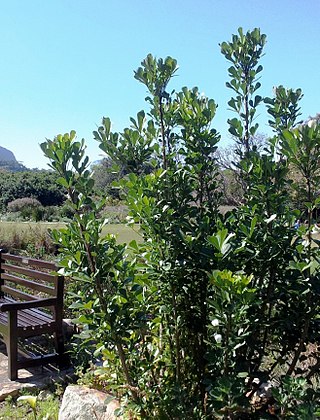
Cussonia thyrsiflora, known as the Cape coast cabbage tree, or Kaapse kuskiepersol in Afrikaans, is a small evergreen tree in the family Araliaceae.
Harmsiopanax ingens of the Gensing, or Ivy Family (Araliaceae), is a very spiney palmlike mesocaul tree endemic to the montane rainforests of central New Guinea which bears a terminal rosette of deeply lobed, meter-wide dentate margined, peltate leaves, maple-like in shape, on equally long petioles. It ultimately attains a height of eighteen meters, at which point it bears a huge panicle of flowers five meters high and equally wide; the largest above ground inflorescence of any dicot plant (although Caloncoba flagelliflora and Ficus geocarpa and Ficus unciata var. strigosa have larger subsurface panicles, each about nine meters in length. H. ingens' panicles are very unusual; the ultimate twigs being spikes each bearing about fifty tiny umbels, each umbel with 8 to 20 minute flowers. So panicle, spike and umbel are all represented in a single inflorescence. Harmsiopanax ingens is monocarpic, and again the largest such plant among dicots. H. ingens was discovered in 1973 by W. R. Philipson. Its native name is "makua".

Neocussonia umbellifera is an evergreen to semi-deciduous Southern African tree of 15-20m growing in escarpment and coastal forest in Malawi, through eastern Zimbabwe and Mozambique along the east coast to South Africa, as far south as the Garden Route. It belongs to the Araliaceae or Cabbage Tree family, and was formerly placed in the genus Schefflera, created by J.R.Forst. & G.Forst. in 1776 to honour the 18th century German physician and botanist Johann Peter Ernst von Scheffler of Danzig, and not to be confused with writer and physician Jacob Christoph Scheffler (1698-1745) of Altdorf bei Nürnberg.
Drypetes gerrardii is a species of small tree or large shrub in the family Putranjivaceae. Common names include forest ironplum, bastard white ironwood, and forest ironwood. It is native to tropical and subtropical central and eastern Africa. It was first described in 1920 by the English botanist John Hutchinson, who named it after the English botanist William Tyrer Gerrard who collected plants and seeds in southern Africa in the 1860s.
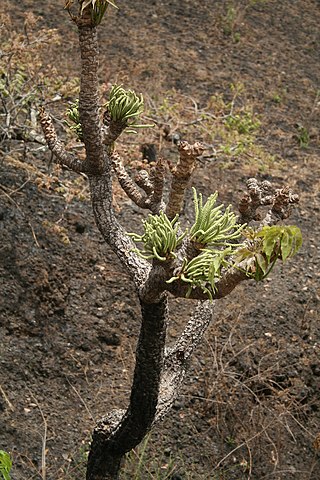
Cussonia arborea is a deciduous small to medium sized tree within the family Araliaceae. Extracts of the species are widely used in traditional medicine to treat a variety of ailments.


